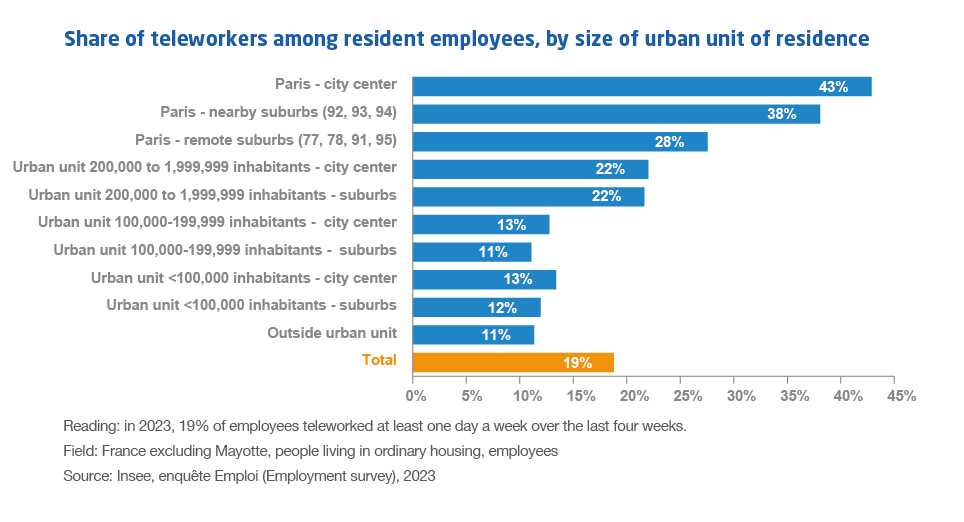Policy brief
The territorial impact of teleworking: a public policy blind spot?
In 2023, 19% of French employees, primarily white-collar workers, teleworked, which is more prevalent in large urban areas. Excluding the Paris region, 22% of employees living in conurbations with over 200,000 inhabitants telework, compared with less than 13% in other agglomerations.
Published on : 14/11/2024
Temps de lecture

The proportion of jobs that can be teleworked also varies across territories: over 50% of jobs in Île-de-France, compared with less than 40% in other regions. In the Île-de-France, teleworking has not reduced road traffic, but has led to a decrease in public transport use during peak hours. Similar trends can be observed in other major metropolitan areas like Lyon, while car traffic has decreased in Rennes and Toulouse.
TER (regional express train) ridership has risen sharply, although this increase cannot be attributed solely to teleworking. It is also contributed to reduce the amount of office space available in major cities and companies. However, other factors influence their real estate strategies, encouraging more on-site presence through attractive workspaces. As a result, there is a trend towards relocating offices to city centers, to the expense of suburbs areas which, when lacking amenities (transportation, services, shops), experience high vacancy rates with no prospect of rapid reuse of available spaces. These trends also pose a risk of crowding out housing in central or better-connected districts.
Teleworking is boosting demand on the housing market, particularly in tourist areas or those well-equipped with urban amenities. From an environmental point of view, although it helps to reduce the number of commuting journeys, it can multiply travel for other reasons. Teleworkers live significantly further from their workplace (28 km on average) than other workers (14 km).
Teleworking produces mixed effects on territories, with a modest accentuation of ongoing trends that are difficult to measure. This makes it difficult to leverage telework as a key tool for public policy. Nevertheless, under specific conditions, it could play a role in rebalancing regions and mitigating climate change.

In partnership with

Téléchargement
The territorial impact of teleworking: a public policy blind spot?
Reference
More
La valeur de l’action pour le climat : une référence pour évaluer et agir
L'Union européenne et la France se sont fixé des objectifs ambitieux de réduction des émissions de gaz à effet de serre, jusqu'à l...
20 March 2025

Travailler dans la fonction publique : le défi de l'attractivité
15 % des postes offerts aux concours de la fonction publique d'Etat non pourvus en 2022, 21 % des lits de l'AP-HP fermés la même a...
09 December 2024

Séminaire Soutenabilités - Digital: new uses, new questions
Although the social, economic, political and geopolitical consequences of the health crisis are only partially visible today, the ...
Study
10 February 2021
